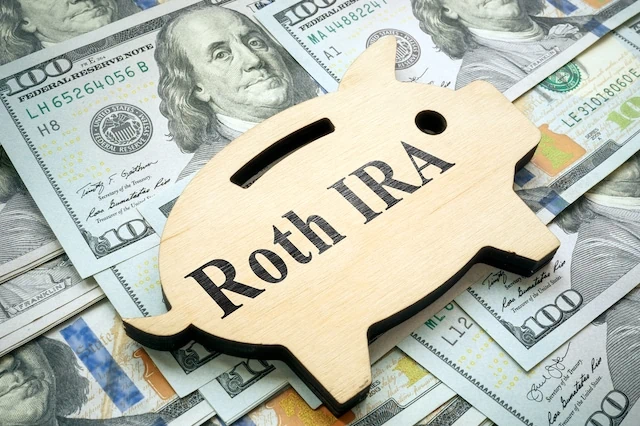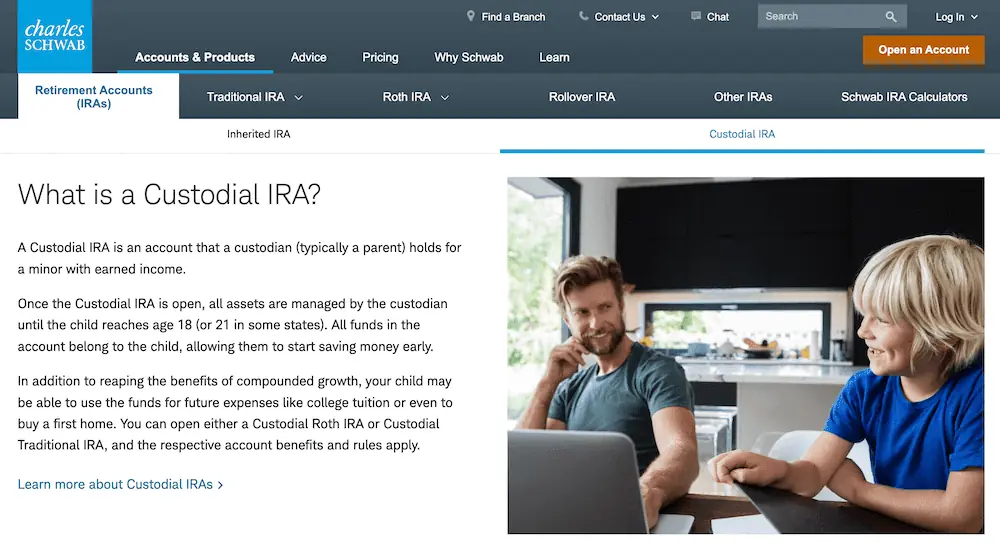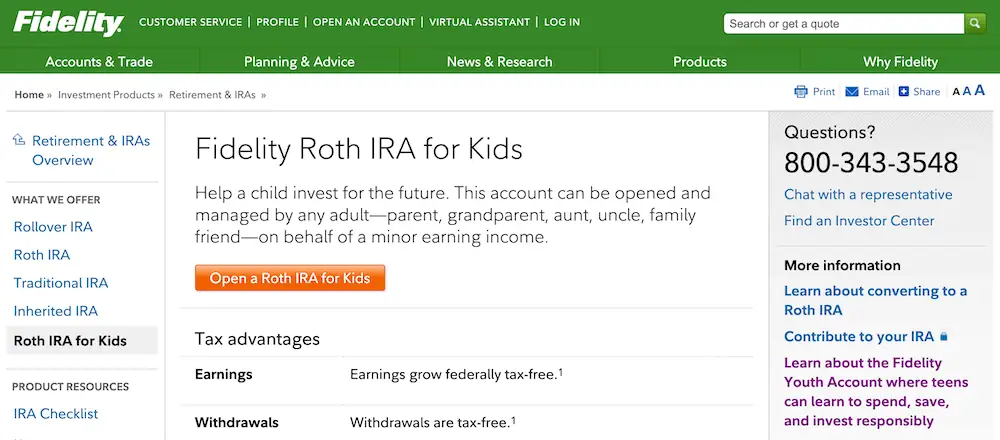Investing isn’t just for adults these days. More and more children are getting into the act with their parents’ assistance. However, if you’re helping your child save for the future, a custodial Roth IRA rarely makes the list of the best investment vehicles. That’s too bad, because Roth IRAs are actually an ideal investment account for kids.
A Roth IRA can be opened for anyone, regardless of their age. Contributions to an account made when your child is at a young age have decades to grow tax-free, too. Plus, contributions can be withdrawn tax- and penalty-free at any time, while earnings can be taken out before retirement age to cover college expenses or buy a home.
And with custodial Roth IRAs, an adult can manage the account until the child reaches the age of majority. That way, there’s proper oversight while your children learn about the benefits of investing. Adults can even help with matching contributions, too.
So, if you want a tax-smart, flexible, and supervised way to help your children invest for the future, consider opening a custodial Roth IRA for your kids. I’ll explain the important rules, tell you want to look for, and even provide recommendations for the best custodial Roth IRAs for children. Read on for all the details about these underappreciated retirement savings vehicles.
Related: How to Invest as a Teenager Under 18
Table of Contents
What Is a Roth IRA?

Let’s start with some of the basics about IRAs and, more specifically, Roth IRAs. There are also some special rules you need to know in order to understand how a Roth IRA for kids works.
First, an IRA—which is short for “individual retirement account”—is a tax-advantaged retirement savings account. In other words, you get tax breaks for using them instead of putting your retirement savings in certain other types of accounts (e.g., a regular savings account from your bank or a standard brokerage account). However, as you’ll see, there are also certain restrictions and limitations that go along with IRAs.
There are two basic types of IRAs: Traditional IRAs and Roth IRAs. The main difference between the two is when you pay taxes on the money in the account (more on that in a second). There are annual contribution limits for both types of IRAs, but there’s an additional income limit for Roth IRAs that prevents wealthier people from contributing to them or contributing as much.
There’s no age limit for IRAs, so there’s no restriction on opening a Roth IRA for kids. But there is an earned income requirement, so a child must have a job or similar source of compensation to contribute to a Roth IRA.
The main purpose of a Roth IRA is retirement saving. However, under certain circumstances, funds in this type of retirement account can be used for other purposes before reaching retirement age. This makes Roth IRAs an especially good investment vehicle for children who have their whole lives ahead of them.
Tax Treatment of Traditional IRAs vs. Roth IRAs
Traditional IRAs are often called “pre-tax” accounts because contributions are made before taxes are imposed on the amount contributed (there’s generally no tax at the time thanks to a tax deduction for the contributions). Money in the account also grows tax-free … until you withdraw funds in retirement. At that point, the money you take out of the account is considered taxable income and you must pay income tax on it.
On the other hand, a Roth IRA is an “after-tax” account, because contributions are made after taxes have been paid on that money. Thus, unlike traditional IRAs, no tax deduction is allowed when you contribute to a Roth IRA. However, once that money is in the Roth IRA, it’s allowed to grow tax-free, and you don’t pay taxes when you withdraw the funds, either.
YATI Tip: Don’t worry too much about your child contributing his or her own money to a Roth IRA. If your child has to file a tax return, the tax rates that kids face are typically so low that taxes on a Roth IRA contribution would mostly be avoided anyway. Plus, since money in a Roth IRA grows tax-free, the “kiddie tax” won’t apply to the investment earnings.
Annual Roth IRA Contribution Limits

An annual contribution limit applies to both types of IRAs. For 2023, the most that can be contributed to a child’s Roth IRA is $6,500 (people 50 or older can contribute $1,000 more).
For 2024, the IRA contribution limit jumps to $7,000 (plus the additional $1,000 if you’re at least 50 years old).
The annual IRA contribution limits are combined limits that apply to all your traditional and Roth IRAs. So, for example, if a child puts $5,000 in a traditional IRA in 2023, then no more than $1,500 can be put in the child’s Roth IRA (or any other IRA) for the 2023 tax year.
Annual Roth IRA Income Limits
As I mentioned earlier, there’s also an income limit and phase-out rules for Roth IRA contributions. So, if your income is too high, you can’t contribute to a Roth IRA at all.
For the 2023 tax year, the annual contribution limit is gradually reduced to zero (you can’t contribute to a Roth IRA if the limit is $0) if your modified adjusted gross income (AGI) for the year is:
- $138,000 to $153,000 for single and head-of-household filers
- $218,000 to $228,000 for joint filers
The phase-out ranges/income limits for the 2024 tax year are as follows (also based on modified AGI):
- $146,000 to $161,000 for single and head-of-household filers
- $230,000 to $240,000 for joint filers
If you’re married but file a separate tax return, your annual maximum contribution is gradually reduced to zero for both years if your modified AGI is between $0 and $10,000.
Related: Child Tax Credit FAQs [What Every Parent Needs to Know]
Earned Income Requirement and Contribution Limit
The account holder must also have earned income in order to contribute to an IRA. If an IRA is in a child’s name, then it’s the child’s earned income that counts.
Also, in addition to the annual contribution limits noted above, IRA contributions for the year can’t exceed the child’s earned income for the year. However, there are still ways for parents, grandparents, or other loved ones to put money in a child’s Roth IRA account.
What is earned income?
According to the IRS, compensation that satisfies the earned income requirement generally includes “wages, salaries, tips, professional fees, bonuses, and other amounts received for providing personal services.” A commission that’s a percentage of profits or sales satisfies the requirement, too.
Self-employment income also counts as earned income. However, if you’re self-employed, don’t include any contributions made to retirement plans on your behalf or the deductible part of your self-employment taxes. Earned income includes self-employment income even if you don’t have to pay self-employment tax because of your religious beliefs. Don’t subtract a net loss from self-employment from salaries or wages when calculating your total earned income.
What’s not treated as earned income? Among other things:
- Interest, dividends, rental income, and other earnings and profits from property
- Pension or annuity income
- Deferred compensation from a previous year
- Amounts excluded from gross income for tax purposes
So, for a kid’s Roth IRA, the necessary income can come from an after-school or summer job (including online jobs for teenagers). It can also come from walking dogs, mowing lawns, babysitting, or performing other jobs kids can do to make money. However, allowance money or financial gifts for babies or other kids don’t count toward a child’s earned income.
Earned income limit for child’s Roth IRA
Even though Roth IRA contributions to a kid’s account can’t exceed the child’s earnings, that doesn’t mean it has to be the child’s money that’s contributed to the account. Parents and other adults can contribute to a child’s Roth IRA—up to the amount of the child’s earned income. For instance, if Johnny earns $2,500 during the year by walking dogs in the neighborhood after school, his parents can contribute up to $2,500 of their money into his Roth IRA, while Johnny keeps the money he earned from dog walking.
A child can also choose to work, but only contribute gift money received for holidays, birthdays, or other celebrations to his or her Roth IRA. Again, the child can’t contribute more than his or her earned income for the year (or more than the annual contribution limit for the year).
Deadline for Contributing to a Roth IRA
You have until the tax filing deadline for the year to make contributions to a Roth IRA. So, for example, you have until April 15, 2024 (April 17 for residents of Maine and Massachusetts), to put money in an account for the 2023 tax year.
If you request an automatic filing extension for your 2023 tax return, you’ll have until Oct. 15, 2024, to contribute to a Roth IRA for the 2023 tax year. Similar deadlines will apply for 2024 IRA contributions.
YATI Tip: If you make a 2023 contribution in 2024, make sure you let the account administrator know that the contribution is for the 2023 tax year.
Use of Roth IRA Funds
Because IRAs are retirement accounts, a 10% penalty might be imposed if you withdraw money from an IRA before you’re 59½ years old. The distribution might also be considered taxable income if you’re not yet 59½ years old.
The early withdrawal penalty and tax generally apply if you pull either contributions or investment earnings out of a traditional IRA, or if you withdraw earnings from a Roth IRA. (You can withdraw contributions from a Roth IRA at any time, since taxes have already been paid on your contributions.)
However, there are exceptions to the 10% penalty for certain circumstances or if the withdrawn funds are used for particular purposes. Some of the more common situations or uses of money that trigger a penalty-free withdrawal before age 59½ include:
- You’re totally and permanently disabled.
- The funds are used to buy, build, or rebuild a first home (including to pay typical closing costs).
- You have unreimbursed medical expenses exceeding 7.5% of your adjusted gross income for the year.
- You’re paying health insurance premiums while unemployed.
- The withdrawn funds aren’t more than your qualified education expenses.
Related: Best Investments for Roth IRA Accounts
What Is a Custodial Account?

If you open a Roth IRA for kids, it can be set up as a custodial account. In that case, the Roth IRA is held in the name of the child by a custodian, who manages the account for the benefit of the child. Custodians can technically be any adult, but they’re usually the child’s parent, guardian, grandparent, or other relative.
With custodial Roth IRAs, the custodian maintains full control over the account until the child reaches the termination age, which is usually when the child reaches the age of majority. This can be when the child turns 18 years old; however, depending on the child’s state of residence, it can also be as late as age 21 or 25. At this point, the child can make decisions as he or she sees fit with how funds get invested, contributed, or spent.
YATI Tip: A custodian can generally withdraw contributions (but not investment earnings) from a custodial Roth IRA tax-free and penalty-free at any time. However, if possible, it’s usually best to keep funds in the account and continue to invest for the child’s retirement. That way, the child’s money stays invested and can continue to benefit from tax-free growth.
When contributions are made into a custodial Roth IRA, it’s considered an irrevocable gift that now belongs to the child. As a result, unlike 529 plans or other tax-advantaged savings accounts for kids, assets placed into custodial Roth IRAs can’t be transferred to another person.
Custodial accounts generally offer flexibility, too. Money held in a custodial account typically can go toward any number of expenses—as long as they benefit the child. For example, funds in a custodial brokerage account don’t need to be earmarked for one specific purpose, such as how money in a 529 plan generally must go toward qualified education expenses. (However, custodial Roth IRAs will have the same spending limitations as Roth IRAs for adults.) There’s general flexibility in how you invest custodial account funds for the benefit of a child as well. The account can hold investments in stocks, bonds, ETFs, mutual funds, and other traditional financial assets.
And custodial accounts are an excellent tool for teaching kids about money. By saving and investing with real money they’ll actually control one day, children can see firsthand how funds in a custodial account can grow over time. They can also learn how to research stocks. Parents also feel more comfortable knowing that this learning process is supervised while the account is still under the custodian’s control.
Related: Roth IRA vs. 529 Plan: Which Is Better For College Savings?
What’s the Best Custodial Roth IRA for Kids?

Now that you know more about Roth IRAs and custodial accounts, perhaps you’re ready to take the next step and open a Roth IRA for your child.
You have many different options for custodial Roth IRAs, including investing with a brokerage or bank. In most cases, your Roth IRA for kids should be an investment account. Brokerage accounts offer much higher potential returns than bank Roth IRAs, most of which only allow you to invest in CDs, money market accounts, and other interest-bearing products.
While there’s no black-and-white “best account,” there are some considerations that can help you make a decision for what will work best for your individual financial situation.
- Fees. This is one of the most common considerations when choosing an account. Typically, custodial accounts have low or no fees if you’re a customer with a brokerage firm. Some firms charge trading commissions, while others opt for a monthly or annual fee. A free stock trading app might also come with the account. Some brokers even offer free stocks for signing up and opening an account.
- Account minimums. Before opening an account, look into how much you’ll need to cough up as an initial deposit and the minimum account balance you’ll need to maintain.
- Investment options. You’ll also want to think about the types of investment options available. Some custodial accounts offer a wide range of investment choices, while others provide guardrails with fewer choices but simplified offerings.
- Investment support. You shouldn’t need to be an investment professional with ten years of Wall Street experience to manage your account. However, sometimes you want a little help beyond your own knowledge or a simplified menu of investment options. Some brokers offer research and resources to help you make your own stock picks, while others provide free personal advice and support. Choose the online broker that meets your needs.
If you need some additional help picking the right custodial Roth IRA for you, read on to see my top picks available today.
1. E*Trade

- Available: Click “Open Account” below
- Platforms: Web, mobile app (Apple iOS, Android)
Most people know E*Trade as one of the leading providers of individual brokerage accounts, but you can also put the powerful platform to work saving for your child’s future.
E*Trade’s IRA for Minors offering allows you to open up a traditional custodial IRA or a custodial Roth IRA for children under age 18 who have earned income. Within the account, you can build a personalized portfolio through thousands of stocks, bonds, ETFs, and mutual funds, or you can have E*Trade select your holdings for you through its Core Portfolio robo-advisory service.
Just like with its individual brokerage accounts, E*Trade custodial IRAs offer zero-commission stock, ETF, and options trading. It also has a leg up on some platforms by offering $0-commission mutual fund, Treasury, and new-issue bond trading.
And if you want to learn more about investing—or want your young one to learn alongside you—E*Trade also boasts educational resources, including articles, videos, classes, monthly webinars, and even live events.
Read our review to learn more, or visit E*Trade and sign up by clicking “Open Account” below.
- E*Trade is one of the best online and mobile trading platforms among discount brokers, offering a full range of investments.
- E*Trade's IRA for Minors allows children under 18, who have earned income, to start saving for their retirement.
- The platform's custodial IRA allows you to build your own portfolio of stocks, ETFs, mutual funds, bonds, and more, or it can build one for you through its Core Portfolios service.
- $0 commission trading for online U.S.-listed stocks, ETFs, options, mutual funds, Treasuries, and new-issue bonds.
- Opening an account is easy and only takes a couple of minutes.
- Excellent selection of available investments
- Commission-free trading on stocks, ETFs, mutual funds, and Treasuries
- Automated portfolio builders and prebuilt mutual fund and ETF portfolios
- Limited availability of fractional shares (only in DRIP plans or robo-created portfolio)
2. Vanguard

- Available: Call 800-551-8631
- Price: Free online trades
If you’d like to open a custodial Roth IRA with Vanguard, you’ll need to call them at 800-551-8631 during normal business hours (you can’t do it online).
There are no fees to trade stocks, ETFs, and Vanguard mutual funds online. However, you need to put in at least $1,000 for any of their all-in-one target date mutual funds or for the Vanguard STAR Fund (VGSTX). A minimum investment of $3,000 (or more) is required for most other Vanguard mutual funds.
Vanguard also charges a $20 annual maintenance fee for most accounts, but it will waive this fee if you choose to sign up for their e-statement delivery service.
Looking for help making investment decisions? Vanguard has plenty of free general advice on their website, plus tools and calculators. They have a robo-advisor tool as well. For a fee, Vanguard also offers individualized professional guidance and wealth management services.
3. Charles Schwab

- Available: Download paper application
- Price: Free online trades
Charles Schwab offers a custodial Roth IRA with no minimum balance and no annual maintenance fee. There’s also no charge for online trades of listed stock, ETFs, and mutual funds (although a service charge may apply for broker-assisted trades).
The broker has a number of financial products to consider as a discount brokerage. For instance, among other things, you can open a Schwab target date fund or invest in index funds.
As with other large brokers, Schwab provides access to no-cost research and information to help you make informed investment decisions. Schwab customers also have access to a robo-advisor. Personalized assistance is available for a fee if you have a larger account.
4. Fidelity Investments

- Available: Sign up here
- Price: Free online trades
Unlike Vanguard or Schwab, Fidelity lets you open a custodial Roth IRA online. Their accounts generally don’t require a minimum balance, but certain investments (e.g., mutual funds) might require a minimum initial investment.
There’s no annual maintenance fee for Fidelity accounts, either. There’s also no commission for online U.S. stock, ETF, and options trades (although charges for certain expenses may apply).
Fidelity offers a wide variety of investment options to consider, including several target date funds and low-cost index funds. As one of the big-boy brokerage firms, they also have a deep reservoir of free investing and general financial advice, tools, and fee-based wealth management services.
Related:








